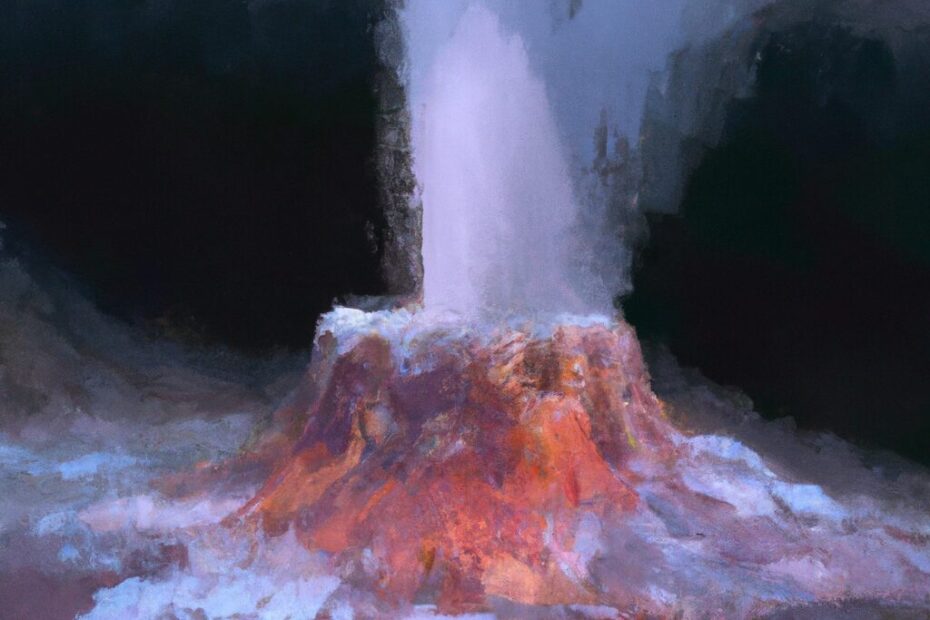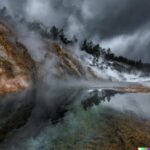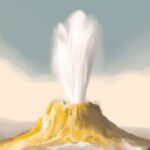Are you fascinated by natural wonders and geothermal activity? If so, you’ll want to learn all about the Grand Geyser. This impressive natural phenomenon is located in a unique geological area and has a fascinating eruption schedule.
From predicted eruption times to the history of past eruptions, this article will explore all you need to know about the Grand Geyser. We’ll discuss the factors that affect its eruption schedule, the best time to witness the eruption, and other geysers in the area.
So, grab your virtual hiking boots and let’s explore the world of the Grand Geyser together!
What Is the Grand Geyser?
The Grand Geyser, situated in Yellowstone National Park, is a remarkable geothermal feature that showcases the wonders of nature unfolding over geological time.
Its unique characteristics include its towering eruptions that can reach up to 200 feet high, making it one of the tallest geysers in the world. This natural phenomenon is intricately connected to the underground network of hot springs and geothermal activity that underlies the Yellowstone region. The Grand Geyser’s eruptions are a result of superheated water expanding and erupting through the narrow vents in the Earth’s crust, a process shaped by centuries of hydrothermal activity and mineral deposits.
Where Is the Grand Geyser Located?
The Grand Geyser is located in the heart of Yellowstone National Park, emerging from the Earth’s surface as a mesmerizing geothermal spring.
This iconic geothermal feature can be found in the Upper Geyser Basin, a hotspot for thermal activity in the park. The Grand Geyser’s eruptions reach impressive heights, showcasing the raw power of geothermal energy beneath the park’s surface. Visitors flock to witness the spectacular displays of water and steam as they are propelled upwards in a stunning natural performance.
The geothermal activity at the Grand Geyser is a testament to the geological forces at work within Yellowstone National Park, making it a must-see attraction for nature enthusiasts and geology buffs alike.
What Is the Eruption Schedule of Grand Geyser?
The eruption schedule of the Grand Geyser is a fascinating display of nature’s predictability, following a specific interval and timing for its breathtaking eruptions.
Visitors to Yellowstone National Park often marvel at the Grand Geyser’s reliability in erupting approximately every 7 to 15 hours. This regularity allows park rangers to predict with impressive accuracy when the next eruption will occur, making it a popular attraction for those eager to witness the powerful display of water and steam shooting up to 200 feet into the air. The eruptions themselves are characterized by a series of bursts and pauses, creating a mesmerizing performance that captivates spectators from around the world.
Predicted Eruption Time
The predicted eruption time of the Grand Geyser offers geyser enthusiasts a glimpse into the meticulously calculated schedule of these awe-inspiring natural phenomena.
Geysers’ predictions are based on a combination of historical data analysis, hydrogeological surveys, and observations of precursor activities such as water temperature fluctuations and steam emissions. By studying the behavior patterns preceding eruptions, researchers can forecast the next eruption window with increasing accuracy. This predictive modeling not only enhances the understanding of geyser dynamics but also serves practical purposes by allowing visitors to plan their visits to witness these extraordinary displays of natural power at the Grand Geyser.
Actual Eruption Time
Observing the actual eruption time of the Grand Geyser is a thrilling experience for geyser watchers, offering a firsthand view of the dynamic geyser activity in action.
As the moment approaches, there’s a palpable buzz of anticipation among the gathered spectators. The Grand Geyser rumbles, sending powerful jets of scalding water and steam high into the air. The precision timing of the eruption is a testament to the dedication of geyser watchers who diligently monitor the subtle cues and signs leading up to this spectacular event. Witnessing the grand display of nature’s power leaves one in awe, highlighting the raw beauty and unpredictability of geyser activity. It’s an unforgettable experience that showcases the marvels of our natural world.
Duration of Eruption
The duration of a Grand Geyser eruption is a captivating display of nature’s power and beauty, offering spectators a mesmerizing glimpse into the eruption patterns of this geothermal wonder.
During these eruptions, the varying lengths can range from several minutes to over half an hour, creating a sense of anticipation and awe among onlookers. As the eruption process unfolds, one can observe the rhythmic spurts of boiling water shooting high into the air, accompanied by billowing clouds of steam. The mesmerizing spectacle is enhanced by the roaring sound of the geyser, reverberating through the surrounding landscape. It’s truly a sight to behold, showcasing the raw, untamed energy of the Earth’s geothermal forces.
What Factors Affect the Eruption Schedule of Grand Geyser?
Several factors influence the eruption schedule of the Grand Geyser, including geothermal activity, seismic events, and the imperative consideration of geothermal safety measures.
Geothermal activity plays a significant role in the timing and intensity of eruptions at the Grand Geyser. The heat from the Earth’s core powers the geothermal features of the area, leading to the build-up of pressure beneath the geyser. Seismic activity, such as earthquakes or tremors, can also impact the geyser’s behavior by altering underground water flow patterns and pressurizing the geothermal system.
To ensure the safety of visitors and the preservation of the geothermal environment, maintaining proper geothermal safety measures is crucial. These measures involve monitoring geothermal features closely to anticipate potential hazards and prevent any harm to both people and the delicate ecosystem.
Weather Conditions
Weather conditions play a significant role in influencing the eruption schedule of the Grand Geyser, particularly in geothermal areas where climatic fluctuations can impact the geyser’s activity.
The Grand Geyser, like many geysers, is highly sensitive to changes in atmospheric conditions. The variations in temperature, air pressure, and precipitation can all affect the delicate balance required for a geyser to erupt. In geothermal areas, where hot water and steam are trapped beneath the Earth’s surface, these climatic shifts can have a profound effect on the pressure build-up needed to trigger an eruption. Understanding how weather patterns interact with the underground geothermal processes is crucial for predicting and studying geyser behavior.
Earthquakes
Earthquakes can disrupt the eruption schedule of the Grand Geyser, highlighting the seismic vulnerability of geothermal regions and the importance of geological mapping for understanding these dynamic geological processes.
When seismic activities occur in geothermal areas like the Grand Geyser, they can trigger changes in the underground plumbing system, altering the flow of water and energy that ultimately impact the geyser’s eruption patterns.
Through geological mapping, scientists can identify fault lines and potential earthquake zones, allowing for better monitoring and prediction of seismic events. This knowledge is crucial for maintaining the safety of both visitors and local communities who rely on geothermal resources while also aiding in the preservation of these unique natural wonders.
Geothermal Activity
Geothermal activity directly influences the eruption schedule of the Grand Geyser, necessitating constant geothermal monitoring to track changes in the hydrothermal system and ensure the geyser’s safety.
This monitoring is crucial for understanding the underlying processes that drive the geyser’s eruptions. By observing variations in temperature, pressure, and other geophysical parameters, researchers can anticipate when the geyser is likely to erupt next. Geothermal monitoring helps in assessing the stability of the hydrothermal system, detecting any anomalies that could signal potential risks such as increased pressure or changes in water chemistry. This proactive approach not only enhances our understanding of geothermal dynamics but also plays a vital role in safeguarding the surrounding environment and visitors to the area.
What Is the History of Grand Geyser Eruptions?
The history of Grand Geyser eruptions is intertwined with the geological formations and geologic processes that have sculpted this iconic geyser over time.
The story of Grand Geyser dates back to a time when volcanic activity shaped the landscape, laying the foundation for the unique hydrothermal features found in Yellowstone National Park. Over centuries, the deposition of minerals, particularly silica-rich compounds, has contributed to the distinctive formations surrounding the geyser.
The interplay of underground water sources, heat from the Earth’s core, and geological fault lines has created the conditions necessary for Grand Geyser’s powerful eruptions. These geologic processes continue to influence the behavior of Grand Geyser, offering a glimpse into the dynamic earth processes at work in this geothermal wonderland.
What Is the Best Time to See the Grand Geyser Eruption?
For geyser enthusiasts and nature photography aficionados, determining the best time to witness the Grand Geyser eruption is a quest for capturing the perfect moment in the geyser’s awe-inspiring display.
Timing plays a crucial role in capturing the Grand Geyser at its majestic best. Typically, the most optimal time to see this natural spectacle is early in the morning when the sunlight illuminates the water spray, creating a magical effect.
Visiting during the shoulder seasons of spring or fall can offer unique lighting conditions and smaller crowds, allowing for a more intimate experience with the geyser. Patience is key when planning your visit, as nature’s timing is unpredictable, but the reward of witnessing the Grand Geyser in all its glory makes the wait worthwhile.
What Other Geysers Can Be Seen Near Grand Geyser?
In the vicinity of the Grand Geyser, visitors can marvel at other geysers such as the iconic Old Faithful and the captivating Turbulent Pool, offering opportunities for wildlife watching and nature exploration.
Old Faithful is renowned for its regular eruptions, often reaching heights of over 100 feet, captivating onlookers with its spectacular displays. Turbulent Pool, on the other hand, entices visitors with its striking turquoise waters and unique bubbling patterns, creating a mesmerizing sight. These geothermal marvels not only showcase nature’s power but also provide a habitat for diverse wildlife species. From bison grazing nearby to colorful birds soaring above, the geysers offer a prime vantage point for observing Yellowstone’s rich ecosystem in action.
Old Faithful Geyser
Old Faithful Geyser, a renowned geothermal feature near the Grand Geyser, attracts visitors with its predictable eruptions and serves as a model for promoting sustainable tourism in geothermal regions.
The reliability of Old Faithful Geyser’s eruptions, which occur approximately every 90 minutes, allows visitors to plan their visits with confidence, enhancing the overall experience. This predictability is not only a fascinating natural phenomenon but also a vital tool in managing tourist flows and minimizing negative environmental impacts.
By showcasing the power and beauty of geothermal features like erupting hot springs and steaming pools, Old Faithful serves as an educational beacon, raising awareness about the sustainable use of geothermal resources and the importance of preserving such natural wonders for future generations.
Castle Geyser
Castle Geyser, in proximity to the Grand Geyser, offers a glimpse into the fascinating realm of hydrogeology and the abundant geothermal resources that shape the geologic landscape of Yellowstone National Park.
Nestled within the vibrant thermal features of the park, Castle Geyser stands as a testament to the powerful forces at work beneath the Earth’s surface. Its cone, resembling a castle turret, erupts with scalding water and steam on a regular basis, captivating visitors with its impressive displays. The hydrogeological processes that fuel Castle Geyser’s eruptions are a reminder of the interconnectedness of water, heat, and rock layers deep underground. This geyser’s contribution to the overall geologic richness of Yellowstone National Park cannot be overstated, as it highlights the dynamic nature of geothermal activity in this unique ecosystem.
Riverside Geyser
Riverside Geyser, adjacent to the Grand Geyser, beckons travelers with its allure of geothermal tourism and serves as a focal point for ongoing geothermal research initiatives exploring the park’s thermal wonders.
Visitors are captivated by the rhythmic eruptions of scalding water at Riverside Geyser, a mesmerizing display of nature’s power and beauty. Scientists and geothermal enthusiasts are drawn to this site not just for its aesthetic appeal, but for the valuable data it provides in understanding the geothermal processes that shape Yellowstone. The unique geological features surrounding Riverside Geyser offer a canvas for researchers to delve deeper into the complex interplay of heat, water, and rock that underpins the park’s geothermal activity.
Last Updated on February 11, 2024 by Jon Waraas – Originally Posted: February 11, 2024

I’m Jon Waraas, and I’ve been navigating the online world since 2006. By day, I’m the proud owner of some eCommerce gems, and by night, I’m the voice behind the adventures on Waraas.Com.
My heart, however, belongs to the wild beauty of Yellowstone National Park. I’ve got a collection of websites dedicated to sharing the wonders of this natural masterpiece. Oh, and did I mention? I’m currently building my own cabin inside the ghost town of Gilmore, Idaho – a cabin with tales to tell!
When I’m not immersed in the digital realm, you’ll find me lacing up my boots for a good hike or setting up camp under the star-studded sky.




